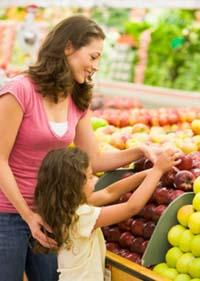 There has been a considerable amount of information written about the negative effects of consuming fruits and vegetables sprayed with pesticides. Children are at an increased risk since they have decreased body weight, internal organs that are still growing and immature immune systems.
There has been a considerable amount of information written about the negative effects of consuming fruits and vegetables sprayed with pesticides. Children are at an increased risk since they have decreased body weight, internal organs that are still growing and immature immune systems.
One of the ways we can reduce our children’s exposure to pesticides in produce is by educating ourselves about safe practices to engage in when purchasing produce, as well as how we “handle our produce” before serving it.
Although organic is an ideal choice, due to the economy it is unrealistic to expect that everyone can afford to purchase 100% organic produce. On the other hand, if we know which fruits and vegetable have the highest levels of pesticides, we can make wise choices about which produce to purchase organic or from the farmers market. Even if the item from the farmers market is not organic, there is usually information posted frequently stating that the farm where it was grown does not use pesticides.
Listed below are the fruits and vegetables that contain the highest, as well as the lowest amount of pesticides. Remember that produce has been handled several times from picking the produce on the farms, placing it in containers and trucks and shipping it to your supermarket.
I have also included helpful tips on helpful ways to clean and handle your produce once you have returned home from shopping.
Follow these easy tips to reduce your child’s exposure to pesticides in produce:
The following sixteen fruits and vegetables are listed as having the highest in pesticides by the Environmental Working Group: Listed left to right in order of the highest pesticide load.
Peaches (highest), Apples, Sweet Bell Peppers, Celery
Nectarines, Strawberries, Cherries, Kale
Lettuce, Imported Grapes, Carrots, Pears
Collard Greens, Spinach, Potatos, Green Beans
The following sixteen fruits and vegetables are listed as having the lowest in pesticides by the Environmental Working Group: Listed left to right in order of the lowest pesticide load.
Onion (lowest), Avocado, Frozen Sweet Corn, Pineapple
Mango, Asparagus, Frozen Sweet Peas, Kiwi
Cabbage, Eggplant, Papaya, Watermelon
Broccoli, Tomato, Sweet Potato, Grapefruit
Tips for Handling & Cleaning Fresh Produce:
- Wash your hands for at least 20 seconds before handling any food.
- Prior to placing in the refrigerator, wash and scrub all produce [even organic] under a stream of cold water to remove any bacteria or pesticides. Utilize a scrub brush [specific only for cleaning produce] or your hands. Do not use a brush used to scrub chicken or other poultry or meat.
- When refrigerating food keep in mind that cold foods may slow the growth of harmful bacteria. A constant refrigerator temperature of 40ºF or below is one of the most effective methods to reduce harmful bacterial growth.
Stay Contamination-Free in the Kitchen:
- Any surface area, cutting board or utensil needs to be cleaned with soap and water. Anything used to dry your produce should not be moist or wet. If you use a sponge, it needs to have been thoroughly cleaned. Dry paper towels or clean cloth towels are usually a better choice.
- Store perishable fruits and vegetables (such as strawberries, lettuce, herbs, and mushrooms) in a clean refrigerator kept at 40 degrees or below, per the FDA recommendation. And always refrigerate produce that was purchased pre-cut or peeled, to maintain quality and safety.
Eat healthy and for more information, visit these sites:
http://www.epa.gov/pesticides/factsheets/kidpesticide.htm
http://www.foodnews.org/fulllist.php
http://www.globalhealingcenter.com/effects-of-pesticides.html
http://www.cape.ca/children/neuro6.html
Linda Winkler Garvin, R.N., M.S.N., of Alameda, California, is Director of Health Management Associates, a senior advocate and health educator with an advanced degree in Gerontological Nursing. She assists individuals in navigating the complexities of their health problems from medical treatment, health insurance issues, chronic diseases and chronic pain. She is the author of several articles including, nutrition, health insurance, guided imagery & chronic health problems. Learn more at www.healthmanagerbayarea.com or e-mail at garvin_linda@yahoo.com.
